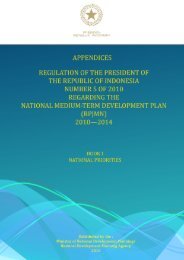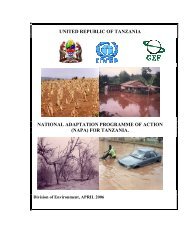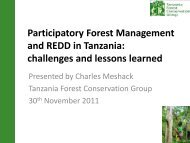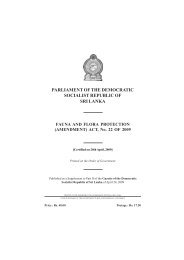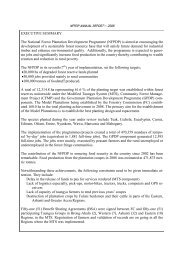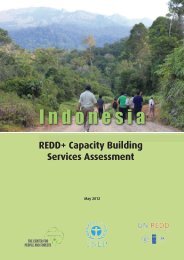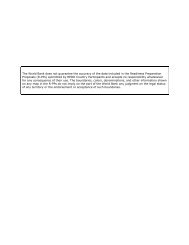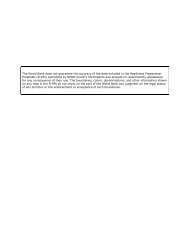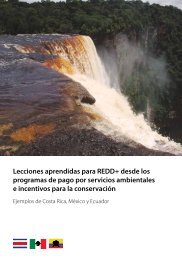Law on Land - Vientiane Times
Law on Land - Vientiane Times
Law on Land - Vientiane Times
You also want an ePaper? Increase the reach of your titles
YUMPU automatically turns print PDFs into web optimized ePapers that Google loves.
Translati<strong>on</strong> Endorsed by the <str<strong>on</strong>g>Law</str<strong>on</strong>g> Committee of the Nati<strong>on</strong>al Assembly of the Lao PDRArticle 7.Prohibiti<strong>on</strong> of <strong>Land</strong> Speculati<strong>on</strong>Illegal land occupati<strong>on</strong> for the purpose of land speculati<strong>on</strong> performedbefore or after the promulgati<strong>on</strong> of the C<strong>on</strong>stituti<strong>on</strong> and this law is herebycancelled.It is prohibited to speculate <strong>on</strong> land; any individual or organisati<strong>on</strong>wishing to use land is required to have an authorizati<strong>on</strong> from the State.Part II<strong>Land</strong> Management and Registrati<strong>on</strong>Chapter I<strong>Land</strong> ManagementArticle 8. (New) <strong>Land</strong> Management Organisati<strong>on</strong> 8The land management organisati<strong>on</strong> 9 in the Lao PDR c<strong>on</strong>sists of:• Nati<strong>on</strong>al land management authority 10 ;• Provincial [and] 11 city land management authorities;• District [and] municipal land management authorities;• Village land units.8In the Lao language, the word roughly meaning “the entire organisati<strong>on</strong> of resp<strong>on</strong>siblegovernmental agencies” is capable of being translated as any <strong>on</strong>e of the following English words:“organisati<strong>on</strong>”, “agency”, or “authority”. In choosing which English word to use, the translators haveadopted the following c<strong>on</strong>venti<strong>on</strong>. Where the governmental agencies in questi<strong>on</strong> have in practiceadopted an English term for themselves (e.g., the Tax Authority), the translators have used that term.Otherwise, as in this <str<strong>on</strong>g>Law</str<strong>on</strong>g>, the translators have used the generic term “organisati<strong>on</strong>”. See also nextfootnote.9Readers should note that, at the time of translati<strong>on</strong>, this <str<strong>on</strong>g>Law</str<strong>on</strong>g> was recently enacted and thecentralised land management organisati<strong>on</strong> c<strong>on</strong>templated by this Article had not yet been set up. Rather,the translators understand that land management resp<strong>on</strong>sibility is currently exercised by severalseparate governmental agencies. The translators were therefore unable to resolve certain word choices(e.g., whether to use “authority” or “organisati<strong>on</strong>”) based <strong>on</strong> knowledge of actual practice. Also, theLao language does not require that nouns c<strong>on</strong>tain informati<strong>on</strong> as to whether they are singular or plural.To resolve these issues, the translators have adopted the following c<strong>on</strong>venti<strong>on</strong>: (i) “organisati<strong>on</strong>” isused to refer to the overall governmental structure resp<strong>on</strong>sible for land management; and (ii)“authority” is used to refer to individual governmental agencies (whether at ministerial, divisi<strong>on</strong>al,central or local levels).10This is a reference to the c<strong>on</strong>templated land management authority at central level (ascompared to the other c<strong>on</strong>templated land manage authorities to be established at various local levels).The translators are unable to resolve definitively whether there will be <strong>on</strong>e or more of such central levelauthorities.11In Lao, a comma is often used, without further elaborati<strong>on</strong>, to mean “and”. Wherever theintended meaning is clear, the translators have translated such commas in <strong>on</strong>e of two ways: (i) bydeleting the comma and substituting it with the word “and’ in square brackets (i.e., [and]); or (ii) byretaining the comma and adding the word “and” in square brackets (i.e., , [and]). Where the meaning ismore ambiguous, the translators have translated the text literally, retaining the comma al<strong>on</strong>e. Here, acomma has been replaced by [and].3
Translati<strong>on</strong> Endorsed by the <str<strong>on</strong>g>Law</str<strong>on</strong>g> Committee of the Nati<strong>on</strong>al Assembly of the Lao PDRThe use of water area land shall comply with the followingc<strong>on</strong>diti<strong>on</strong>s 21 :1. Not cause erosi<strong>on</strong>;2. Not cause obstructi<strong>on</strong> to waterways;3. Not cause water levels to recede or to flood;4. Not pollute or pois<strong>on</strong> bodies of water;5. Not cut trees or destroy the forest in water catchment areas;6. Not dig or take away soil from swamps and wetlands, [except] inthe case of necessity with prior authorizati<strong>on</strong> from the c<strong>on</strong>cernedorganisati<strong>on</strong>.Article 26. (New)Use of Water Area <strong>Land</strong>The village administrati<strong>on</strong> where the water area land is located ischarged with studying and making proposals to the district or municipaladministrati<strong>on</strong> c<strong>on</strong>cerning the allocati<strong>on</strong> of such land to individuals ororganisati<strong>on</strong>s for appropriate protecti<strong>on</strong> and use.If water area land is formed within the scope of the right to use [waterarea land] of an individual or organisati<strong>on</strong>, then if the water and waterresource management organisati<strong>on</strong>s and the Science, Technology andEnvir<strong>on</strong>mental Agency have found that the use of such land will not causenegative impacts <strong>on</strong> the water area land, such land shall be under the right touse of that individual or organisati<strong>on</strong>.Chapter 5Management of Industrial <strong>Land</strong>Article 27. (New)Industrial <strong>Land</strong>Industrial land is the land area or regi<strong>on</strong> which is determined by theState to be the locati<strong>on</strong> of workshops [and] factories[,] including the housingplaces for workers, industrial centres, industrial z<strong>on</strong>es, industrial estates,places for industrial, technical and scientific research, waste-water treatmentstati<strong>on</strong>s, industrial waste disposal sites, energy sources, electricitytransmissi<strong>on</strong> lines, energy and gas pipe-lines, pipe-lines for water supply,mining areas, and other land used for industrial purposes.21The translators are aware that this list of c<strong>on</strong>diti<strong>on</strong>s might have been better expressed asapplying to “users” of water area land rather than the “use” of water area land.9
Translati<strong>on</strong> Endorsed by the <str<strong>on</strong>g>Law</str<strong>on</strong>g> Committee of the Nati<strong>on</strong>al Assembly of the Lao PDRArticle 28.Management of Industrial <strong>Land</strong>The Ministry of Industry and Handicrafts is charged with managingindustrial land, [and] with studying and developing regulati<strong>on</strong>s <strong>on</strong> themanagement, protecti<strong>on</strong>, development, and use of this category of land,including envir<strong>on</strong>mental protecti<strong>on</strong>, and. thereafter, submitting [them] to thegovernment for c<strong>on</strong>siderati<strong>on</strong> and approval.In the case of the management of land used for electricity transmissi<strong>on</strong>lines, energy and gas pipelines, and pipe-lines for water supply, it is requiredto coordinate with the transport, post and c<strong>on</strong>structi<strong>on</strong> sector and otherc<strong>on</strong>cerned sectors.Article 29.Regulati<strong>on</strong>s <strong>on</strong> the Use of Industrial <strong>Land</strong>Individuals and organisati<strong>on</strong>s using industrial land shall comply withthe following c<strong>on</strong>diti<strong>on</strong>s:1. Have been authorised by the industry and handicrafts sector;2. Have been authorised by the town planning organisati<strong>on</strong>s;3. Cause no harm to any other pers<strong>on</strong>, to the public or to theenvir<strong>on</strong>ment;4. Repair and restore the land to its previous c<strong>on</strong>diti<strong>on</strong> after using theland for mining.Chapter 6Management of Communicati<strong>on</strong> <strong>Land</strong>Article 30.Communicati<strong>on</strong> <strong>Land</strong>Communicati<strong>on</strong> land is land which has been used or reserved formaking roads, side-walks [and] water channels 22 , [for] road c<strong>on</strong>structi<strong>on</strong>,bridge sites, teleph<strong>on</strong>e transmissi<strong>on</strong> lines, [and] telecommunicati<strong>on</strong>s stati<strong>on</strong>s,as well as airports, harbours, stati<strong>on</strong>s for goods and passenger transport,tunnels, railways, warehouses, and other land used for communicati<strong>on</strong> andtransportati<strong>on</strong>.Article 31.Management of Communicati<strong>on</strong> <strong>Land</strong>The Ministry of Communicati<strong>on</strong>, Transport, Post and C<strong>on</strong>structi<strong>on</strong> ischarged with managing communicati<strong>on</strong> land, [and] with studying anddeveloping regulati<strong>on</strong>s <strong>on</strong> the management, protecti<strong>on</strong>, development, and useof this category of land and, thereafter, submitting [them] to the governmentfor c<strong>on</strong>siderati<strong>on</strong> and approval.22This is a reference to drains and other channels for the passage of water, rather than to largewaterways.10
Translati<strong>on</strong> Endorsed by the <str<strong>on</strong>g>Law</str<strong>on</strong>g> Committee of the Nati<strong>on</strong>al Assembly of the Lao PDRArticle 32.Use of Communicati<strong>on</strong> <strong>Land</strong>The use of communicati<strong>on</strong> land shall be in accordance with regulati<strong>on</strong>swhich are specifically issued by the c<strong>on</strong>cerned organisati<strong>on</strong>.Chapter 7Management of Cultural <strong>Land</strong>Article 33.Cultural <strong>Land</strong>Cultural land is the locati<strong>on</strong> of cultural heritage and is related to thehistorical routes, traditi<strong>on</strong>al objects, archaeological sites, temples, naturallandscape, cultural buildings, and other places which are determined by theState to be cultural and tourist land.Article 34.Management of Cultural <strong>Land</strong>The Ministry of Informati<strong>on</strong> and Culture is charged with managingcultural land throughout the country, [and] with studying and developingregulati<strong>on</strong>s <strong>on</strong> the management, protecti<strong>on</strong>, development, and use of thiscategory of land and, thereafter, submitting [them] to the government forc<strong>on</strong>siderati<strong>on</strong> and approval.Individuals or organisati<strong>on</strong>s using cultural land shall comply withregulati<strong>on</strong>s <strong>on</strong> the management, use, and protecti<strong>on</strong> of cultural land.Chapter 8Management of <strong>Land</strong> for Nati<strong>on</strong>al Defence and SecurityArticle 35.<strong>Land</strong> for Nati<strong>on</strong>al Defence and Security<strong>Land</strong> for nati<strong>on</strong>al defence and security is land used for nati<strong>on</strong>aldefence and security work, such as: military camps[;] the locati<strong>on</strong>s of offices,army units, housing places, schools, military and police training fields, andartillery fields[;] military and police airports, harbours, warehouses, hospitals,workshops, factories, [and] recreati<strong>on</strong>al places[;] and other land which is usedfor nati<strong>on</strong>al defence and security.Article 36. (New)Management of <strong>Land</strong> for Nati<strong>on</strong>al Defence and SecurityThe Ministry of Nati<strong>on</strong>al Defence and the Ministry of Security arecharged with managing land for nati<strong>on</strong>al defence and security, [and] withstudying and developing regulati<strong>on</strong>s <strong>on</strong> the management, protecti<strong>on</strong>,development, and use of this category of land under their management and,thereafter, submitting [them] to the government for c<strong>on</strong>siderati<strong>on</strong> andapproval.11
Translati<strong>on</strong> Endorsed by the <str<strong>on</strong>g>Law</str<strong>on</strong>g> Committee of the Nati<strong>on</strong>al Assembly of the Lao PDRArticle 37.Use of <strong>Land</strong> in Other Categories for Nati<strong>on</strong>al Defence and SecurityIn the case of necessity, the nati<strong>on</strong>al defence and security forces canuse other categories of land, whether they are owned by individuals ororganisati<strong>on</strong>s[,] for nati<strong>on</strong>al defence and security activities, based <strong>on</strong> thedecisi<strong>on</strong> of the government.After the land is no l<strong>on</strong>ger needed, it shall be returned to its formerowner. If the use has caused damage to the possessor of the land use rights ofdeveloped land, compensati<strong>on</strong> for such damage should be c<strong>on</strong>sidered in anappropriate manner.Chapter 9Management of C<strong>on</strong>structi<strong>on</strong> <strong>Land</strong>Article 38.C<strong>on</strong>structi<strong>on</strong> <strong>Land</strong>C<strong>on</strong>structi<strong>on</strong> land is land used for the c<strong>on</strong>structi<strong>on</strong> of residentialplaces, buildings, workshops, factories, offices, premises of organisati<strong>on</strong>s,[and] public facilities.Article 39. (New)Management of C<strong>on</strong>structi<strong>on</strong> <strong>Land</strong>The nati<strong>on</strong>al land management authority is charged with managingc<strong>on</strong>structi<strong>on</strong> land, [and] with studying and developing regulati<strong>on</strong>s <strong>on</strong> themanagement, protecti<strong>on</strong>, development, and use of this category of land and,thereafter, submitting [them] to the government for c<strong>on</strong>siderati<strong>on</strong> andapproval.Article 40.Categories of C<strong>on</strong>structi<strong>on</strong> <strong>Land</strong>C<strong>on</strong>structi<strong>on</strong> land is divided into the following categories:• C<strong>on</strong>structi<strong>on</strong> land for public facilities;• C<strong>on</strong>structi<strong>on</strong> land for residential places;• C<strong>on</strong>structi<strong>on</strong> land for workshops and factories;• C<strong>on</strong>structi<strong>on</strong> land for offices and premises of organisati<strong>on</strong>s.C<strong>on</strong>structi<strong>on</strong> land for public facilities is land used for collectivebenefit, such as public parks, schools, hospitals, markets, children’splaygrounds, sports stadiums, and other [facilities] which are for public use.C<strong>on</strong>structi<strong>on</strong> land for residential places is land used for building placesof residence for individuals and families.C<strong>on</strong>structi<strong>on</strong> land for workshops and factories is land used forindustrial producti<strong>on</strong> and processing.12
Translati<strong>on</strong> Endorsed by the <str<strong>on</strong>g>Law</str<strong>on</strong>g> Committee of the Nati<strong>on</strong>al Assembly of the Lao PDRC<strong>on</strong>structi<strong>on</strong> land for offices and premises of organisati<strong>on</strong>s is landused for building offices and premises of State agencies and organisati<strong>on</strong>s,enterprises, embassies, or internati<strong>on</strong>al organisati<strong>on</strong>s.The allocati<strong>on</strong> of c<strong>on</strong>structi<strong>on</strong> land shall be made in accordance withthe town plan and with the proporti<strong>on</strong> of c<strong>on</strong>structi<strong>on</strong> allocated to eachcategory.Article 41.Regulati<strong>on</strong>s <strong>on</strong> the Use of C<strong>on</strong>structi<strong>on</strong> <strong>Land</strong>The State shall make a reserve of c<strong>on</strong>structi<strong>on</strong> land for public facilitiesto use for collective benefit. If there is a wish to change the objectives of theuse of such land, [such land] must still be used for collective benefit and thisrequires the prior c<strong>on</strong>sent of the c<strong>on</strong>cerned agency.The use of c<strong>on</strong>structi<strong>on</strong> land shall cause no harm to the interests of anyother pers<strong>on</strong> and shall be based <strong>on</strong> an actual situati<strong>on</strong>. All c<strong>on</strong>structi<strong>on</strong> mustreceive authorizati<strong>on</strong> from the town planning organisati<strong>on</strong>, be strictlyundertaken in accordance with the town planning regulati<strong>on</strong>s, receiveauthorizati<strong>on</strong> from the c<strong>on</strong>cerned competent authority, fully c<strong>on</strong>form withtechnical standards, and ensure the protecti<strong>on</strong> of the envir<strong>on</strong>ment.Article 42.Determinati<strong>on</strong> of Scope of C<strong>on</strong>structi<strong>on</strong> <strong>Land</strong> Use RightsThe State authorises individuals and families to use c<strong>on</strong>structi<strong>on</strong> landaccording to its objective, in an effective manner, in peaceful enjoyment, forthe l<strong>on</strong>g term, and in an area not exceeding eight hundred square meters perpers<strong>on</strong> in the family.When granting approval for the use of c<strong>on</strong>structi<strong>on</strong> land toorganisati<strong>on</strong>s for use, [such approval] shall be based <strong>on</strong> the actual capacity ofsuch organisati<strong>on</strong>.Chapter 10<strong>Land</strong> Registrati<strong>on</strong>Article 43. (New)<strong>Land</strong> Registrati<strong>on</strong><strong>Land</strong> registrati<strong>on</strong> is the certificati<strong>on</strong>, in accordance with the laws, ofthe land use rights of an individual or organisati<strong>on</strong> in order to avoid thefalsificati<strong>on</strong> of land use rights, and to facilitate the management and protecti<strong>on</strong>of land in a uniform manner throughout the whole country.<strong>Land</strong> registrati<strong>on</strong> is [carried out] by recording data in the land registerbook[,] such as names and surnames of the pers<strong>on</strong> who has the land use rights,(names of the husband and wife who have received the land use rights if theland is matrim<strong>on</strong>ial property), as well as the land category, land boundariesand area, method of acquisiti<strong>on</strong>, and land locati<strong>on</strong>.Article 44.Form of <strong>Land</strong> Registrati<strong>on</strong>13
Translati<strong>on</strong> Endorsed by the <str<strong>on</strong>g>Law</str<strong>on</strong>g> Committee of the Nati<strong>on</strong>al Assembly of the Lao PDR<strong>Land</strong> registrati<strong>on</strong> c<strong>on</strong>sists of two forms which are:• Systematic land registrati<strong>on</strong>;• <strong>Land</strong> registrati<strong>on</strong> based <strong>on</strong> request.Systematic land registrati<strong>on</strong> is registrati<strong>on</strong> without request which issystematically undertaken in a particular area where the management of land,the classificati<strong>on</strong> of land regi<strong>on</strong>s, and the classificati<strong>on</strong> of land categories formanagement are necessary.<strong>Land</strong> registrati<strong>on</strong> based <strong>on</strong> request is registrati<strong>on</strong> which is performedaccording to the request made by any individual or organisati<strong>on</strong> that requiresthe certificati<strong>on</strong> of land use rights.Article 45. (New)Request for <strong>Land</strong> Registrati<strong>on</strong>An individual or organisati<strong>on</strong> that wishes to register its land shallsubmit a request, through the village administrati<strong>on</strong> and the district [or]municipal land management authority, to the provincial [or] city landmanagement authority.The request for land registrati<strong>on</strong> shall c<strong>on</strong>sist of the followingdocuments:1. Certificate of acquisiti<strong>on</strong> of the land such as: certificate of landallocati<strong>on</strong> by the State, [certificate of] transfer or inheritance;2. The land certificate in the case of agricultural land or forestland 23 ;3. Certificate of land guarantee from the original owner 24 or from thelocal administrati<strong>on</strong>s of the place where the land is located;4. Other necessary documents.Article 46. (New)Review of Request for <strong>Land</strong> Registrati<strong>on</strong>When the file of the request for land registrati<strong>on</strong> has been received bythe district or municipal land management authority, this authority shallreview the facts and the laws and regulati<strong>on</strong>s, in coordinati<strong>on</strong> with the villageadministrati<strong>on</strong> where the land is located. Within thirty days, the district ormunicipal land management authority must give an answer to the applicant.If it is found that all the informati<strong>on</strong> is in c<strong>on</strong>formity with the actualfacts and the laws and regulati<strong>on</strong>s, the officers at the [land] measurement unitshall undertake a measurement and make a land parcel map which is to beattached to the request file and then submitted to the provincial or city landmanagement authority for c<strong>on</strong>siderati<strong>on</strong> of land registrati<strong>on</strong>.23This refers to the three-year land certificates.24This refers to a document c<strong>on</strong>taining an assurance that the original owner had the right totransfer the land to the current owner.14
Translati<strong>on</strong> Endorsed by the <str<strong>on</strong>g>Law</str<strong>on</strong>g> Committee of the Nati<strong>on</strong>al Assembly of the Lao PDRArticle 47.The <strong>Land</strong> RegisterThe land register is the book used to record land registrati<strong>on</strong>[sequentially] according to serial numbers. The land register has the signatureand seal of the head of the land management authority 25 <strong>on</strong> the first page, anda page number and a seal mark <strong>on</strong> each page.The land register shall have the following main c<strong>on</strong>tents:1. Name and surname of the individual or organisati<strong>on</strong> holding theland use right;2. Date, m<strong>on</strong>th and year of birth, nati<strong>on</strong>ality, occupati<strong>on</strong>, [and]present address of the holder of the land use right;3. Names of the father and mother of the holder of the land use right;4. Lot number of the land;5. Code number of the land parcel map;6. <strong>Land</strong> boundaries, area and land category;7. <strong>Land</strong> map 26 ;8. Serial number [of the land use right].Article 48.<strong>Land</strong> CertificateA land certificate is an official document certifying the temporary useright of agricultural land or forest land which is issued by the district ormunicipal administrati<strong>on</strong> to an individual or organisati<strong>on</strong> that has the right touse such land.An individual or organisati<strong>on</strong> that has the land certificate has the rightrelating to inheritance 27 in the land according to the term of the landcertificate, but shall not have the right to transfer or use the land certificate asshare c<strong>on</strong>tributi<strong>on</strong> 28 , or to use it as security or to lease [it].Article 49. (New)<strong>Land</strong> TitleA land title is the <strong>on</strong>ly document which is c<strong>on</strong>sidered as the mainevidence for permanent land use rights. It is filled out based <strong>on</strong> informati<strong>on</strong> inthe land register in <strong>on</strong>e copy <strong>on</strong>ly and is handed over to the land owner whoshall keep it as l<strong>on</strong>g-term evidence until there is a change according to thec<strong>on</strong>diti<strong>on</strong>s prescribed in the laws.25Due to the ambiguities menti<strong>on</strong>ed in c<strong>on</strong>necti<strong>on</strong> with Article 8, it is unclear whether this is areference to the head of a local land registrati<strong>on</strong> authority, the head of a nati<strong>on</strong>al land registrati<strong>on</strong>authority or the head of the overall land registrati<strong>on</strong> organisati<strong>on</strong>.26The actual map should be c<strong>on</strong>tained in the register.27See Article 58. This refers to the right to have the land pass to <strong>on</strong>e’s successors, rather than theright to inherit.28I.e., as a capital c<strong>on</strong>tributi<strong>on</strong> into an enterprise.15
Translati<strong>on</strong> Endorsed by the <str<strong>on</strong>g>Law</str<strong>on</strong>g> Committee of the Nati<strong>on</strong>al Assembly of the Lao PDRBefore issuing the land title, the c<strong>on</strong>cerned organisati<strong>on</strong> shall post upan informati<strong>on</strong> notice at the land management authorities, the district ormunicipal administrati<strong>on</strong> office, [and] the village administrati<strong>on</strong> office wherethe land is located, and shall issue a notificati<strong>on</strong> by using the State media,putting a notice in newspapers [or] making an announcement over the radio ortelevisi<strong>on</strong> according to the actual situati<strong>on</strong> for a period of ninety days from thedate of signature of the [informati<strong>on</strong>] notice in order to inform the public.During this period, if no claims are raised, or if the claims are resolved, theland title shall then be issued to the holder of the land use rights.Article 50. (New)Issuance of a Copy of the <strong>Land</strong> TitleIf the land title is lost or destroyed but evidence of certificati<strong>on</strong> is kept,the provincial or city land management authority will issue a copy of the landtitle to the individual or organisati<strong>on</strong> that requests it.If there is no trace of the lost or destroyed land title which can be usedas evidence certifying that it is truly the c<strong>on</strong>cerned land title, it is required thatbefore a copy of the land title can be issued, there shall be a decisi<strong>on</strong> of thelocal people's court at the place where the land is located.In all cases, the issuance of a copy of the land title shall be preceded byan informati<strong>on</strong> notificati<strong>on</strong> to the public for a period of thirty days inaccordance with regulati<strong>on</strong>s.Article 51. (New)Registrati<strong>on</strong> of Legal Transacti<strong>on</strong>s Relating to <strong>Land</strong>The registrati<strong>on</strong> of legal transacti<strong>on</strong>s relating to land is the recording ofall the transacti<strong>on</strong>s [or] changes in land use rights in the book for registrati<strong>on</strong>of legal transacti<strong>on</strong>s at the district or municipal land management authorityaccording to the delegati<strong>on</strong> of power from the provincial or city landmanagement authorities to m<strong>on</strong>itor the status of transacti<strong>on</strong>s and changesrelating to such land.Part IIIRights and Obligati<strong>on</strong>s of the <strong>Land</strong> UserChapter 1Rights and Obligati<strong>on</strong>s of a Lao Citizen C<strong>on</strong>cerning the <strong>Land</strong>Article 52.Acquisiti<strong>on</strong> of <strong>Land</strong> Use RightsAn individual or organisati<strong>on</strong> will acquire land use rights <strong>on</strong> any <strong>on</strong>e ofthe following bases:1. Allocati<strong>on</strong> by the State;2. Transfer;3. Inheritance.16
Translati<strong>on</strong> Endorsed by the <str<strong>on</strong>g>Law</str<strong>on</strong>g> Committee of the Nati<strong>on</strong>al Assembly of the Lao PDRArticle 53. (New) Rights of the Holder of <strong>Land</strong> Use Rights 29The holder of land use rights shall have the following rights:• Right to protect land;• Right to use land;• Right of usufruct;• Right to transfer the land use right;• Right relating to inheritance of the land use right 30 .Article 54.Right to Protect <strong>Land</strong>The right to protect land is the right assigned by the State to anindividual or organisati<strong>on</strong> to protect the land with a view to using it for aspecific purpose.Article 55.Right to Use <strong>Land</strong>The right to use land is the right to use land for certain purposes inorder to provide for the needs of the holder of land use rights, in accordancewith the land allocati<strong>on</strong> plan of the State.Article 56.Right of UsufructThe right of usufruct from developed land is the right of the holder ofland use rights to collect the usufruct or income from such land, such as fromthe lease [of land], or from the use [of land] as a share c<strong>on</strong>tributi<strong>on</strong> orguarantee 31 .Article 57. (New)Right to Transfer <strong>Land</strong> Use RightsThe right to transfer land use rights is the right to give land use rightsto other pers<strong>on</strong>s by sale, transfer or exchange.Article 58. (New)Right Relating to Inheritance of <strong>Land</strong> Use RightsThe right relating to inheritance of land use rights is the right to passland use rights over developed land, in accordance with the laws, to <strong>on</strong>e’shusband or wife, children, grandchildren, parents or close relatives up<strong>on</strong> thedeath of the holder of land use rights.29The term of art “land use rights” is used strictly in this translati<strong>on</strong> to refer to the full packageof these 5 rights (which are akin to the idea of “ownership”) and should be distinguished from the“right to use land” which is <strong>on</strong>ly <strong>on</strong>e of the rights within this package.30See Article 58. This refers to the right to have the land pass to <strong>on</strong>e’s successors, rather than theright to inherit.31This word may also be translated as “security”.17
Translati<strong>on</strong> Endorsed by the <str<strong>on</strong>g>Law</str<strong>on</strong>g> Committee of the Nati<strong>on</strong>al Assembly of the Lao PDRIf the land received by inheritance when added to the area of the landthat the inheritor already uses exceeds the maximum area for the land categoryas prescribed in the laws, then Article 86 of this law will be applied.Article 59.Rights of State Organisati<strong>on</strong>s, Political Organisati<strong>on</strong>s, the LaoFr<strong>on</strong>t for Nati<strong>on</strong>al C<strong>on</strong>structi<strong>on</strong>, Mass Organisati<strong>on</strong>s, andEc<strong>on</strong>omic Organisati<strong>on</strong>s of the State.State organisati<strong>on</strong>s, political organisati<strong>on</strong>s, the Lao Nati<strong>on</strong>al Fr<strong>on</strong>t forNati<strong>on</strong>al C<strong>on</strong>structi<strong>on</strong>, mass organisati<strong>on</strong>s, and ec<strong>on</strong>omic organisati<strong>on</strong>s of theState that have the right to use land <strong>on</strong>ly have the rights to protect and usesuch land and have no right to transfer, lease or grant c<strong>on</strong>cessi<strong>on</strong>s or to useland as a share c<strong>on</strong>tributi<strong>on</strong> or guarantee.Article 60.Obligati<strong>on</strong>s of Pers<strong>on</strong>s who Have the Right to Use <strong>Land</strong> andPers<strong>on</strong>s who Hold <strong>Land</strong> Use Rights 32Pers<strong>on</strong>s having the right to use land and pers<strong>on</strong>s who hold land userights have the following obligati<strong>on</strong>s:1. To use the land according to its objective;2. To not cause damage to land quality and to not cause adverseimpact to the natural or social envir<strong>on</strong>ment;3. To not violate the rights and interest of other pers<strong>on</strong>s;4. To comply with unavoidable circumstances 33 in accordance withthe laws;5. To pay fees 34 relating to the land;6. For the pers<strong>on</strong> who holds land use rights, to fulfil obligati<strong>on</strong>sc<strong>on</strong>cerning land <strong>on</strong> time, such as: payment of land tax, transfertax, tax <strong>on</strong> income from leases, inheritance tax, fees for nametransfer, fees for registrati<strong>on</strong> of legal transacti<strong>on</strong>s relating to land;7. To comply with other regulati<strong>on</strong>s relating to land.Article 61.Unavoidable CircumstancesIf the land of any individual or organisati<strong>on</strong> is surrounded by the landof other pers<strong>on</strong>s and has no access to the road, such individual or organisati<strong>on</strong>has the right to request the holder of land use rights of the land located nearestto the road for an access passage. The holder of land use rights who receivessuch request shall provide the access passage at the place he c<strong>on</strong>siders to beappropriate and has the right to request appropriate compensati<strong>on</strong> for lossescaused to crops, c<strong>on</strong>structi<strong>on</strong>, or other development <strong>on</strong> such land where theaccess passage is required.32“Pers<strong>on</strong>s who have the right to use land” will be used to refer to pers<strong>on</strong>s who <strong>on</strong>ly have “theright to use land”. “Pers<strong>on</strong>s who hold land use rights” will be used to refer to pers<strong>on</strong>s who have the fullpackage of “land use rights”.3334See Article 61.This word may also be translated as “charges”.18
Translati<strong>on</strong> Endorsed by the <str<strong>on</strong>g>Law</str<strong>on</strong>g> Committee of the Nati<strong>on</strong>al Assembly of the Lao PDRArticle 67. (New)Obligati<strong>on</strong>s of Aliens, Apatrids, Foreign Individuals andtheir Organisati<strong>on</strong>s Relating to the Lease or C<strong>on</strong>cessi<strong>on</strong> of<strong>Land</strong>Aliens, apatrids, foreign individuals and their organisati<strong>on</strong>s that leaseor receive c<strong>on</strong>cessi<strong>on</strong>s in land have the following obligati<strong>on</strong>s:1. To use the land in c<strong>on</strong>formity with its objectives;2. To not cause damage to land quality and to not cause adverseimpact to the natural or social envir<strong>on</strong>ment;3. To not violate the rights and interest of other pers<strong>on</strong>s;4. To comply with unavoidable circumstances in accordance with thelaws;5. To fully pay lease and c<strong>on</strong>cessi<strong>on</strong> fees and other fees relating tothe land;6. To fully comply with land regulati<strong>on</strong>s and the c<strong>on</strong>diti<strong>on</strong>s of theland lease or c<strong>on</strong>cessi<strong>on</strong>.Chapter 3Compensati<strong>on</strong> for LossesArticle 68.Reas<strong>on</strong>s [Justifying] Compensati<strong>on</strong> for LossesReas<strong>on</strong>s that [justify] compensati<strong>on</strong> for losses c<strong>on</strong>sist of the following:1. Losses caused by the violati<strong>on</strong> of laws and regulati<strong>on</strong>s;2. Losses caused by unavoidable circumstances;3. Losses caused by land requisiti<strong>on</strong>.Article 69.Compensati<strong>on</strong> for Losses Caused by Violati<strong>on</strong> of <str<strong>on</strong>g>Law</str<strong>on</strong>g>s andRegulati<strong>on</strong>sAny individual or organisati<strong>on</strong> that uses land in violati<strong>on</strong> of laws andregulati<strong>on</strong>s and thereby causes damage to another pers<strong>on</strong> or to the public shallpay compensati<strong>on</strong> for the losses resulting from its acts.Article 70.Compensati<strong>on</strong> for Losses Caused by Unavoidable Circumstances[Where] any individual or organisati<strong>on</strong> acquires, as a result ofunavoidable circumstances, the right to use the land of other pers<strong>on</strong>s whoprovide access passages or water drainage canals and thereby causes losses tothe crops, [or] c<strong>on</strong>structi<strong>on</strong> of such other pers<strong>on</strong>s or the public 43 , suchindividual or organisati<strong>on</strong> shall pay appropriate compensati<strong>on</strong> for such losses.Article 71. (New)Compensati<strong>on</strong> for Losses Caused by <strong>Land</strong> Requisiti<strong>on</strong>43There is a c<strong>on</strong>notati<strong>on</strong> of “the people as a whole” (e.g, in the case where the passage or canalmust pass through State land).22
Translati<strong>on</strong> Endorsed by the <str<strong>on</strong>g>Law</str<strong>on</strong>g> Committee of the Nati<strong>on</strong>al Assembly of the Lao PDRWhen it is necessary to use the land of any individual or organisati<strong>on</strong>for public purposes, the State shall requisiti<strong>on</strong> the land and shall payappropriate compensati<strong>on</strong> to such individual or organisati<strong>on</strong>.In order to ensure compensati<strong>on</strong> for losses caused by land requisiti<strong>on</strong>,land shall be reserved at the rate of five percent of the total land area of thevillage, district, municipality, province, or city. 44During the time that such reserved land has not yet been used, it maybe temporarily leased to individuals or organisati<strong>on</strong>s.Article 72.Determinati<strong>on</strong> of LossesRegarding the compensati<strong>on</strong> for losses, there shall be a committeec<strong>on</strong>sisting of the representatives of c<strong>on</strong>cerned parties which will be chargedwith determining the valuati<strong>on</strong> of the losses.Chapter 4<strong>Land</strong> in respect of which the Administrative Authority had Assigned<strong>Land</strong> Use Rights to the People during the Period of Nati<strong>on</strong>al Liberati<strong>on</strong>and <strong>Land</strong> left by People who have Fled to Foreign CountriesArticle 73.<strong>Land</strong> in respect of which the Administrative Authority hadAssigned <strong>Land</strong> Use Rights to the People during the Period ofNati<strong>on</strong>al Liberati<strong>on</strong>The State does not recognize the claim for land in respect of which theadministrative authority had assigned land use rights to the people during theperiod of nati<strong>on</strong>al liberati<strong>on</strong>.Article 74.<strong>Land</strong> Left by People who Moved to Other Places in the Countryduring the Period of Nati<strong>on</strong>al Liberati<strong>on</strong>The State does not recognize the claim for land of individuals ororganisati<strong>on</strong>s that gave up their land during the period of nati<strong>on</strong>al liberati<strong>on</strong>.44The implicati<strong>on</strong> is that such reserved land is used to compensate for requisiti<strong>on</strong>ed land.23
Translati<strong>on</strong> Endorsed by the <str<strong>on</strong>g>Law</str<strong>on</strong>g> Committee of the Nati<strong>on</strong>al Assembly of the Lao PDRArticle 75.<strong>Land</strong> Given to Become Collective PropertyThe State does not recognize the claim for land that individuals ororganisati<strong>on</strong>s have given to become collective property during the period ofnati<strong>on</strong>al liberati<strong>on</strong> and at the present time.Article 76.<strong>Land</strong> of People who Fled to Other CountriesThe State does not recognize the claim for land left by people who fledto foreign countries.Part IVC<strong>on</strong>trol of <strong>Land</strong> UseArticle 77.C<strong>on</strong>trol 45 of <strong>Land</strong> UseThe c<strong>on</strong>trol of land use is the c<strong>on</strong>trol of the protecti<strong>on</strong>, development,and use of land by individuals and organisati<strong>on</strong>s in order to ensure compliancewith objectives, laws, and regulati<strong>on</strong>s and [to ensure] effective use.Article 78. (New)<strong>Land</strong> Use C<strong>on</strong>trol Organisati<strong>on</strong>sThe c<strong>on</strong>trol of land use of each category of land in order to ensurecompliance with objectives, laws, and regulati<strong>on</strong>s is the resp<strong>on</strong>sibility of theorganisati<strong>on</strong>s charged with the management of the c<strong>on</strong>cerned land categoriesat different levels as prescribed in Article 9 of this law.<strong>Land</strong> allocati<strong>on</strong>, land leases, land c<strong>on</strong>cessi<strong>on</strong>s, and land registrati<strong>on</strong>shall be c<strong>on</strong>trolled by the nati<strong>on</strong>al land management authority.Article 79.Rights and Duties in the C<strong>on</strong>trol of <strong>Land</strong> Use<strong>Land</strong> management authorities have the following rights and duties inthe c<strong>on</strong>trol of land use:1. To demand documents that are necessary for the c<strong>on</strong>trol workfrom c<strong>on</strong>cerned individuals or organisati<strong>on</strong>s;2. To undertake the inspecti<strong>on</strong> of land sites;3. To give advice to pers<strong>on</strong>s who have the right to use land andpers<strong>on</strong>s who hold land use rights;4. To issue orders suspending or temporarily stopping 46 operati<strong>on</strong>srelating to the land which are unlawful;45In the Lao language, the same word is used to represent all of the following related (butslightly different) c<strong>on</strong>cepts: “c<strong>on</strong>trol”, “inspecti<strong>on</strong>”, “supervisi<strong>on</strong>”, “audit” and “m<strong>on</strong>itoring”. As usedin Parts IV and VI of this <str<strong>on</strong>g>Law</str<strong>on</strong>g>, the translators have chosen “c<strong>on</strong>trol” (and its variants) as the mostappropriate English equivalent when referring to general supervisory functi<strong>on</strong>s and “inspect” (and itsvariants) as the most appropriate English equivalent when referring to physical inspecti<strong>on</strong>s. Readersshould note and bear in mind the other meanings that might have been intended.46The translators are aware that “suspending” and “temporarily stopping” appear to beduplicative.24
Translati<strong>on</strong> Endorsed by the <str<strong>on</strong>g>Law</str<strong>on</strong>g> Committee of the Nati<strong>on</strong>al Assembly of the Lao PDR5. To make proposals to c<strong>on</strong>cerned organisati<strong>on</strong>s to c<strong>on</strong>sider thewithdrawal of rights to use land and land use rights;6. To exercise other rights and perform other duties relating to thec<strong>on</strong>trol of land use or land use rights.Part VSettlement of <strong>Land</strong> Problems,Policies Towards Pers<strong>on</strong>s with OutstandingPerformance and Measures Against ViolatorsArticle 80. (New)Settlement of <strong>Land</strong> Problems that have AdministrativeCharacteristicsThe settlement of land problems that have administrativecharacteristics shall be resolved by the c<strong>on</strong>cerned land management authorityin coordinati<strong>on</strong> with the c<strong>on</strong>cerned [local] administrati<strong>on</strong> at that level 47 at theplace where the land is located. [Such problems] include: using land withoutauthorizati<strong>on</strong>, using land in c<strong>on</strong>tradicti<strong>on</strong> of its objectives, laws, andregulati<strong>on</strong>s, not using land within the determined time period after beingallocated [such land], not paying taxes or fees <strong>on</strong> land as determined byregulati<strong>on</strong>s, and other problems having administrative characteristics. 48If the pers<strong>on</strong> having the right to use land or the holder of land userights is not satisfied with the decisi<strong>on</strong> taken for resolving the problem, he hasthe right to request the next higher authority to settle the problem.Article 81. (New)Settlement of <strong>Land</strong> Disputes having the Characteristics of aCivil [Case]The settlement of land disputes having the characteristics of a civil[case], such as: inheritance of developed land, transfer of land use rights, and[disputes under] other civil c<strong>on</strong>tracts relating to land, shall be brought beforethe people's court to c<strong>on</strong>sider 49 according to the laws.Regarding the settlement of land disputes having civil characteristics,the village administrati<strong>on</strong> at the place where the land is located shall firstmediate the dispute[;] if no agreement can be reached, then the case shall besubmitted to the district or municipal administrati<strong>on</strong> to mediate; if settlementfails, then each party has the right to file a claim in court.Article 82. Policies Towards Pers<strong>on</strong>s with Outstanding Performance47“that level” refers to the local administrati<strong>on</strong> at a level corresp<strong>on</strong>ding to the level of thec<strong>on</strong>cerned land management authority.48For readability, the punctuati<strong>on</strong> and sentence structure have been changed.49“C<strong>on</strong>sider” has the c<strong>on</strong>notati<strong>on</strong> that the relevant authority also has the right to render decisi<strong>on</strong>s<strong>on</strong> the matters c<strong>on</strong>sidered.25
Translati<strong>on</strong> Endorsed by the <str<strong>on</strong>g>Law</str<strong>on</strong>g> Committee of the Nati<strong>on</strong>al Assembly of the Lao PDRAn individual or organisati<strong>on</strong> that uses the land or exercises land userights in accordance with laws and regulati<strong>on</strong>s, 50 protects and develops theland in an effective manner shall be rewarded and shall be facilitated inleasing land or receiving land c<strong>on</strong>cessi<strong>on</strong>s and other policies 51 as determinedby the State.Article 83.Measures against ViolatorsAn individual or organisati<strong>on</strong> that violates the laws and regulati<strong>on</strong>srelating to land and causes damage to the public, the envir<strong>on</strong>ment, property,[or] health or life of others shall be fined or punished depending <strong>on</strong> thegravity 52 of the case, including [having to] pay compensati<strong>on</strong> for the lossescaused.In additi<strong>on</strong> to the above-menti<strong>on</strong>ed main punishments, the offendermay receive additi<strong>on</strong>al punishment such as: withdrawal of land certificate,land title, or other certificate c<strong>on</strong>cerning land use or land use rights.Article 84.Penal MeasuresAn individual who has, while performing work c<strong>on</strong>cerning the land,violated the laws and regulati<strong>on</strong>s[,] such as: opportunistic use of positi<strong>on</strong>,abuse of power, taking bribes, [and] falsifying documents for pers<strong>on</strong>albenefit[, and has thereby] caused losses to the interests of the State, collectivesor other individuals[,] shall be subject to criminal penalties includingcompensati<strong>on</strong> of the losses caused.Part VIFinal Provisi<strong>on</strong>sArticle 85. (New)Implementati<strong>on</strong>The government of the Lao People's Democratic Republic has theresp<strong>on</strong>sibility to issue decrees and detailed regulati<strong>on</strong>s to implement this lawand to undertake systematic land c<strong>on</strong>trol throughout the country, particularlyc<strong>on</strong>trol of the acquisiti<strong>on</strong> of land use rights, size of the land, the use of theland, and the exercise of land use rights.50“or”.5152The translators are unable to resolve whether this comma should be interpreted as “and” or“Policies” is used in the sense of “incentives” or “rewards”.Literally “light” or “heavy”.26
Translati<strong>on</strong> Endorsed by the <str<strong>on</strong>g>Law</str<strong>on</strong>g> Committee of the Nati<strong>on</strong>al Assembly of the Lao PDRArticle 86. (New)Time Limit for Settlement [of Problems] Regarding <strong>Land</strong>Lao citizens [who received] 53 land in accordance with laws andregulati<strong>on</strong>s in the past, but the area [of whose land] exceeds the areaprescribed in Articles 17, 21 and 42 of this law, shall arrange for thesettlement [of such problem] in order to comply with the provisi<strong>on</strong>s of this<strong>Land</strong> <str<strong>on</strong>g>Law</str<strong>on</strong>g> within a period of three years commencing from the date of theofficial notificati<strong>on</strong> issued by the government [requiring such pers<strong>on</strong>] to settle[such problem] regarding the excess land officially. If that pers<strong>on</strong> c<strong>on</strong>tinues touse the excess land, he has to pay more taxes than the normal tariff; if [he]fails to do so, he shall lose his rights to use that excess land.Aliens, apatrids, foreign individuals and their organisati<strong>on</strong>s that haveacquired land in the past are required to make arrangements to comply withthis <strong>Land</strong> <str<strong>on</strong>g>Law</str<strong>on</strong>g> within a period of three years commencing from the date of theofficial notificati<strong>on</strong> of the government to the public. After this period, thec<strong>on</strong>cerned pers<strong>on</strong>s will lose the land use rights relating to such land. If theyc<strong>on</strong>tinue to use the land, they shall be given priority to lease or receive ac<strong>on</strong>cessi<strong>on</strong> of such land [from the State].Regarding embassies and internati<strong>on</strong>al organisati<strong>on</strong>s, the decisi<strong>on</strong> shallbe taken by the government.Article 87.EffectivenessThis law shall enter into force <strong>on</strong> the date of the promulgating decreeissued by the president of the Lao People's Democratic Republic.This law supersedes the <strong>Land</strong> <str<strong>on</strong>g>Law</str<strong>on</strong>g> No. 01/97 dated 12 April 1997.void.Regulati<strong>on</strong>s and provisi<strong>on</strong>s which c<strong>on</strong>tradict this law shall be null and<strong>Vientiane</strong>, 21 October 2003President of the Nati<strong>on</strong>al Assembly[Seal and Signature]Samane VIGNAKHET53Literally “having”.27




